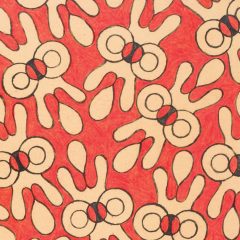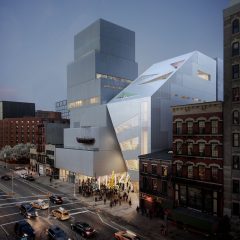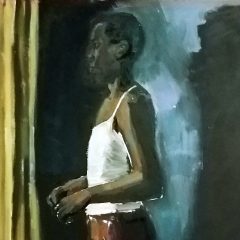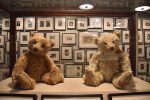Anna Boghiguian pulls no punches in her first solo museum show in the US. The Armenian-Egyptian artist transforms the New Museum’s new South Galleries by painting the gallery’s four walls with a continuous band of yellow ochre at the base, and opaque black on the top two thirds. The stark contrast creates a horizon line that encourages a linear experience of the show. Through her artwork, Boghiguian investigates the binary relationship between rational logic and emotional chaos that weave together through history and contemporary politics.
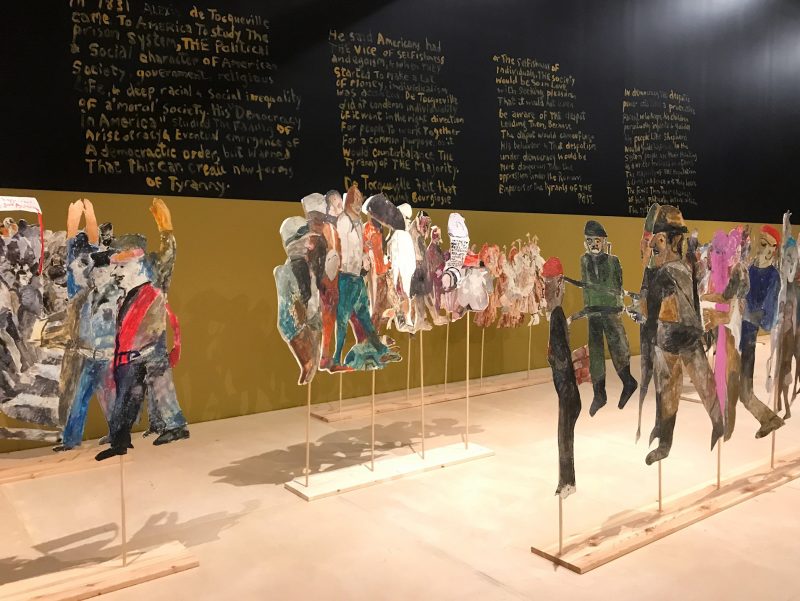
The main feature of the show is the rows of free-standing paper cut-out figures that call to mind Javanese shadow puppets traditionally used for acting out theatrical performances. They show groupings of slaves and plantation workers. Many of these works are part of a series called “Woven Winds / The Making of an Economy – Costly Commodities” from 2016. The most ambitious element in the show is a large-scale eponymous sail fabric painted as a map of the world with flags of various key nation states and the European Union, ships, and an accompanying small mound of dirt with cotton plants appearing to grow out of the gallery floor. The soft puffy cotton balls feel like an innocuous natural science display until you realize how cotton is tied to the abuse and human suffering of African slaves and descendents of slaves who picked the cotton in the American South.
Wall drawings with political and emotional words
Surrounding these two large, major works are the works on the walls, numerous, and whose cumulative power in the exhibition is undeniable. Boghiguian begins The Loom of History with eight modest sized unframed pencil, watercolor, ink and gouache works on paper that collectively are entitled “Nietzsche” and hand-painted wall text that reads: “The Ear has stories & memories. it remembers…” The images feel like intuitive dream-like explorations of the relationship between perception, thought, and emotion. They are drawings of brains, Nietzsche, the words Apollo (rational order) and Dionysus (irrational chaos), as well as some formal explorations that recall Louise Bourgeois’ “Insomnia Drawings” where the process of making reflects a search for form and meaning. Nietzsche is known for exploring the dichotomy between order and disorder, represented by the two Greek gods.
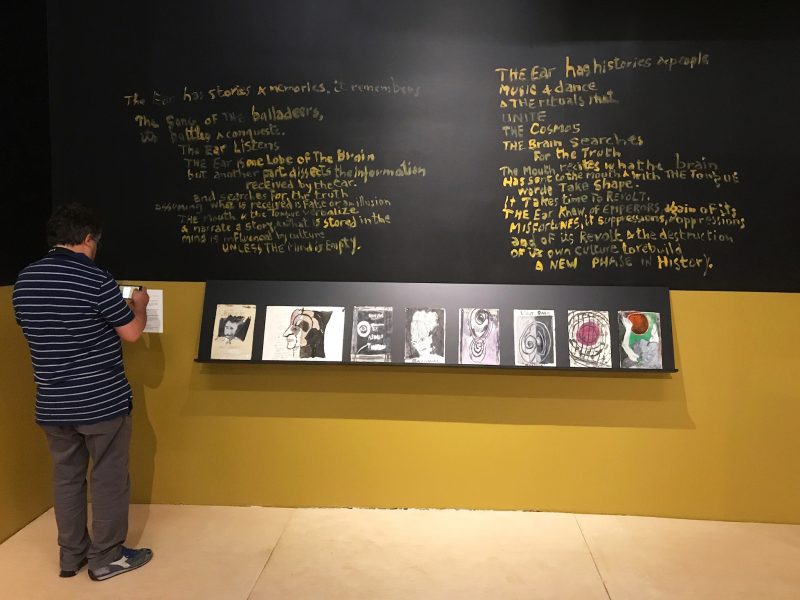
The majority of the black painted wall areas are covered in hand-written text right on the walls. Didactic quotations of historical texts and Boghiguian’s paraphrased analysis of the causal history between trade, colonialism, slavery, the cotton industry, and the cotton gin focus on some of the most problematic parts of early American history. In a quote from Alexis de Tocqueville in his 1835 “Democracy in America”, she highlights the early warnings against unchecked American individualism, unbridled greed, and tyranny. The way the text is drawn on the walls conveys a sense of the artist’s urgency and honesty, words are crossed out, mistakes are left visible. Like Joseph Beuys’ blackboard works that were the remnants of lectures on art and politics he gave at the Tate Modern in London to encourage the creation of a genuine democracy, Boghiguian’s text illuminates the truth and edifies the viewer.
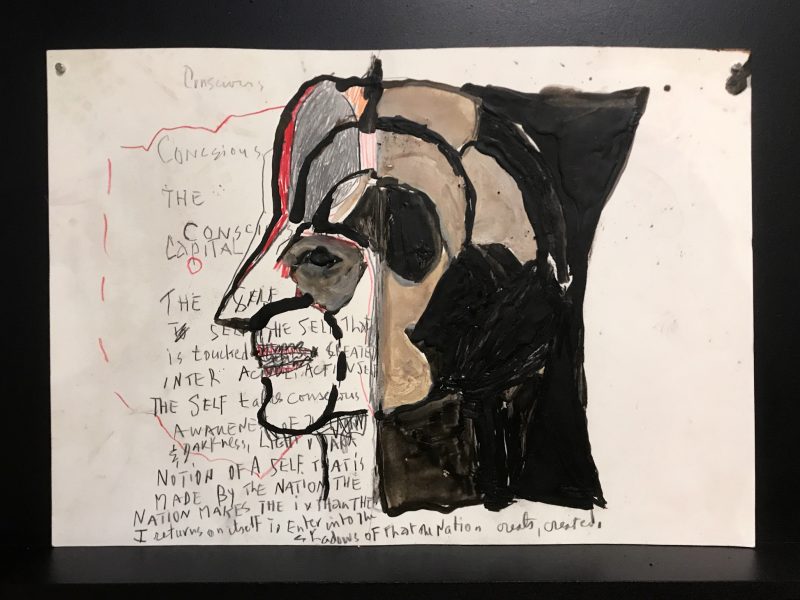
Mixing media to create powerful impact
Similar to the thought provoking, angry and abject collage works by artist Thomas Hirschhorn, Boghiguian’s collages appropriate political photographs and mass media visual ephemera, and combine them with agitated mark making. The collage works are particularly powerful in part due to their hyper-emotional and quick, almost knee-jerk condemnations. They are displayed in dense three-by-five part grids, free-standing framed structures (beehive frames) in works entitled “In the World: East and West, North and South I and II”. Psychological triggers like photos of Adolf Hitler and Benito Mussolini with a grinning chimpanzee between the two dictators as they ride in what might be a motorcade have been added, with the words “Alice in the wonderland” written below them and the barely legible word “remember” written in vertical script. Other collages include political figures including George W Bush with the top of his face covered up, and the words “be careful of people” handwritten below.
Another artwork includes photo of a hand covered in ants hovering about a group of marching African soldiers. The range of image references and frenetic hand-scrawled text related to political protest and discontent imbue the collages with raw, emotional energy and bring the historical and contemporary together in a surprising way. I’m amazed at how an image of the disembodied mouth of today’s POTUS is immediately recognizable as President Trump’s pink gaping mouth covering the head of a black and white photo of a stone effigy of Julius Caesar.
From figurative to abstract, and from science to politics
Contrasting the collage works that combine elements of chaos, historical figures, and visceral cacophony, are a series of organic abstract paintings “Brains I and II”. These mixed media on canvas paintings are organized into grids and look like MRI brain scans.
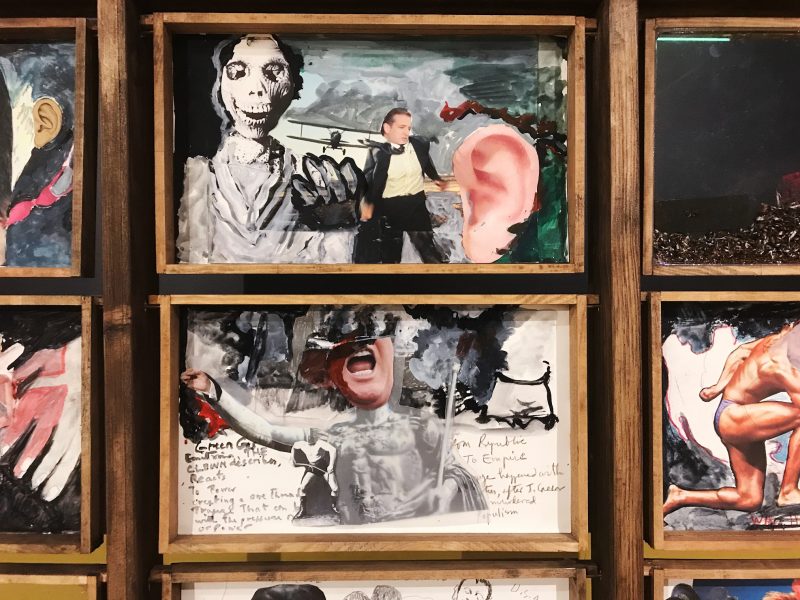
The artist’s fluctuation of focus between biological science and socio-political references makes me think about the subjective experience of processing objective information. We are invited to ask how sense organs like the ear, or the eyes can translate information in different ways depending on perspective, context, and agenda. A large mixed media sculpture with an oversized plastic ear at the center of the work, provocatively entitled “Guilt Machine” from 2013 – makes a viewer contemplate the physical mechanics of receiving and processing information.
What struck me at the end of my gallery visit, was the fact that while the vast majority of the museum visitors were spending a lot of time looking at and processing the artwork in “The Loom of History”, they did so with their arms crossed over their chest, as if to brace themselves for the deluge of uncomfortable truths they were encountering with their rational and emotional selves.
Anna Boghiguian: Loom of History is at the New Museum, New York City, from May 2 – August 19, 2018.


